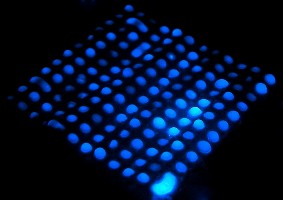
Demonstration of a technique that uses inexpensive paper as a medium for rapid medical diagnostics and chemical analysis. Blood was sprayed on the test strip that turns a fluorescent blue, showing the presence of hemoglobin. (Birck Nanotechnology Center, Purdue University)
Researchers at Purdue University in West Lafayette, Indiana have developed a technique using inexpensive paper to make test strips for more complex medical diagnostics and chemical analysis. The team from Purdue’s engineering school published their findings online this week in the journal Lab on a Chip (paid subscription required).
The researchers say this innovation provides a way to enhance commercially available diagnostic devices that use paper-strip assays for simpler tests like those for diabetes and pregnancy. Engineering professor Babak Ziaie calls it a generic platform that can be used in a number of ways. “This new approach offers the potential to extend the inexpensive paper-based systems,” says Ziaie, “so that they are able to do more complicated multiple analyses on the same piece of paper.”
Current lab-on-a-chip technology requires expensive, custom-designed chips to perform certain types of chemical analyses, with channels created in glass or plastic and tiny pumps and valves directing the flow of fluids for testing. Nonetheless, the chips are used for various applications in medicine and research, measuring specific types of cells and molecules in a patient’s blood, monitoring microorganisms in the environment and in foods, and separating biological molecules for laboratory analysis.
With the new technique, on the other hand, the testing platform is contained on a disposable paper strip containing patterns created by a laser. The researchers start with inexpensive paper having a hydrophobic — i.e., water-repellant — coating, such as parchment paper or wax paper used for cooking, commonly available in retail stores.
A laser then burns off the hydrophobic coatings in lines, dots, and patterns, exposing the underlying water-absorbing paper only where the patterns are formed. As Ziaie explains, “This modified surface has a highly porous structure, which helps to trap and localize chemical and biological aqueous reagents for analysis. Furthermore, we’ve selectively deposited silica microparticles on patterned areas to allow diffusion from one end of a channel to the other.”
Those microparticles help to wick liquid to a location where it combines with another chemical, called a reactant, causing it to change colors, indicating a positive or negative test result. To demonstrate the new concept, the researchers created paper strips containing arrays of dots dipped in luminol, a chemical that turns fluorescent blue when exposed to blood. The proof of concept test — see photo above — showed the presence of hemoglobin.
Read more: Paper Test Strips Developed for Bioactivity
* * *

 RSS - Posts
RSS - Posts
[…] Read More: Paper Strip Technique Devised for Complex Diagnostics […]